Mesquite Flat Sand Dunes is one of the most popular places to hike in the Death Valley National Park.
Information about Mesquite Flat Sand Dunes:
- Location: Mesquite sand dunes are located just east of Stovepipe Wells Village off CA-190.
- Distance of Hike (Roundtrip): 2 miles (3.2 km). To get to the highest dune, you will have to hike about a mile one way.
- Time needed to Hike (Roundtrip): 1.5 hours.
- Difficulty of Hike: Easy/Moderate.
- Elevation Gain: 185 ft (65 m).
- Trail Type: No official trail.
- Parking: Paved lot with pull-through spaces for buses and large RVs.
- Closest Restroom: Vault toilets located in parking lot.
- Route: Area open for cross-country exploration; choose your own route to the tallest dune.
- Pets: Pets are not allowed on the dunes or on any trail in Death Valley National Park.
- Official website: https://www.nps.gov/places/mesquite-flat-sand-dunes.htm
- Fees/Online Tickets: https://www.nps.gov/deva/planyourvisit/fees.htm
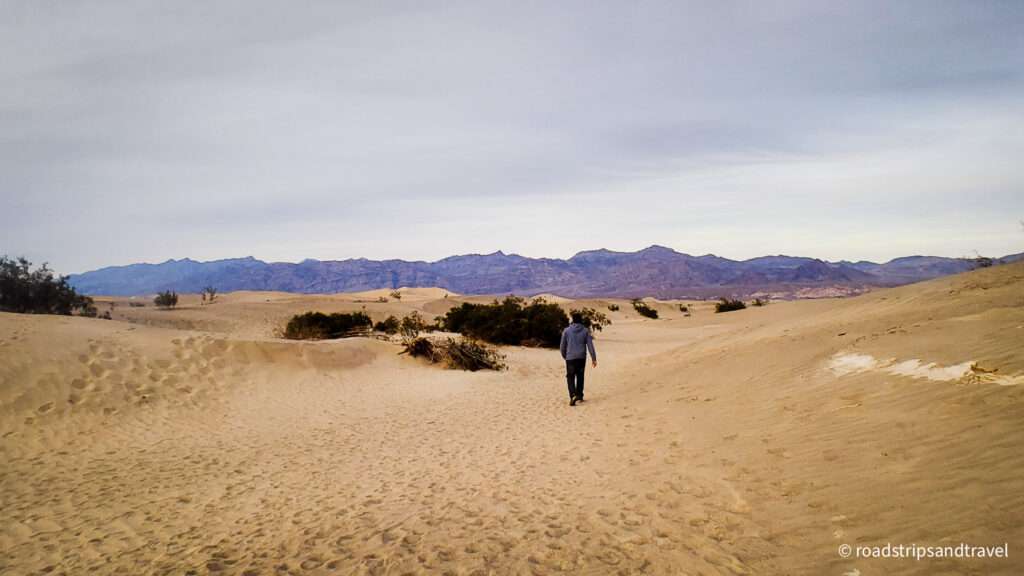
Interesting Facts about Mesquite Flat Sand Dunes:
- Sand dunes appear lifeless at first glance, but below the surface, the dunes provide precious water and an escape from extreme temperatures. Sand dunes provide habitat for many animals, including nocturnal kangaroo rats and sidewinder rattlesnakes.
- In the dunes sparse rainfall doesn’t go to waste. The sand acts like a sponge, absorbing water in the space between individual sand grains. That is why if you dig a few inches into the sand, you can feel moisture and coolness.
- On particularly windy days, you can literally hear the earth sing. This natural phenomenon sounds like humming and it feels like listening to a “Choir of sand”.
- A large area of rarely visited dunes is to the east where you may find footprint-free sand for photography.
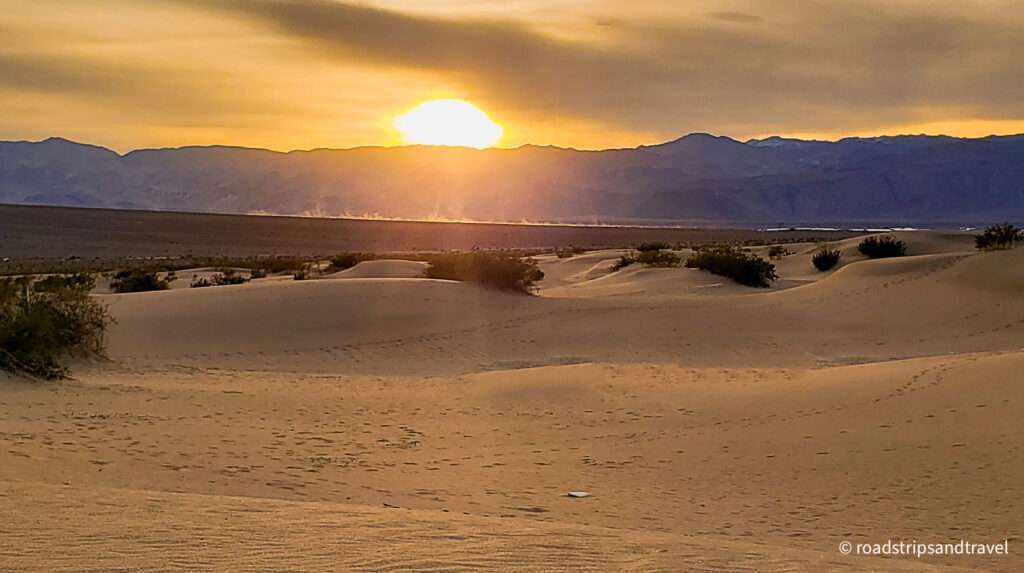
Travel tips while hiking Mesquite Flat Sand Dunes:
- The best seasons to visit are spring, fall and winter. Summers are scorchingly hot and it is not advisable to hike these dunes during summer.
- When hiking the dunes always carry water, a protective hat and sunscreen.
- It is recommended to wear sturdy and closed footwear year round to protect yourself from the coarse sand grains, although some people would love to walk barefoot on sand.
- Mesquite Sand Dunes are the perfect location for watching the sunrise or sunset. The Mesquite Dunes are known for their dramatic shadows at sunrise and sunset, as ripples and edges in the dunes stand out in greater contrast.
- The best time to hike the dunes is early in the morning or late in the day. The advantage of going there very early in the morning is that the night winds will have erased the footprints from the visitors of the previous day, leaving the natural ripples on the dunes. This is simply a magnificent sight!
- On a dawn hike you may see the tracks of nocturnal animals too. Moonlight hikes are magical, but if you are hiking at night be on the lookout for rattlesnakes and other nocturnal animals.
- Mesquite Dunes are a great place to observe Death Valley’s famous dark night skies.
- There is no official trail path, so be aware of where you are going as it is easy to get lost.
- We visited in February and there were considerably less crowds and after hiking for about half a mile, we had the dunes to ourselves.
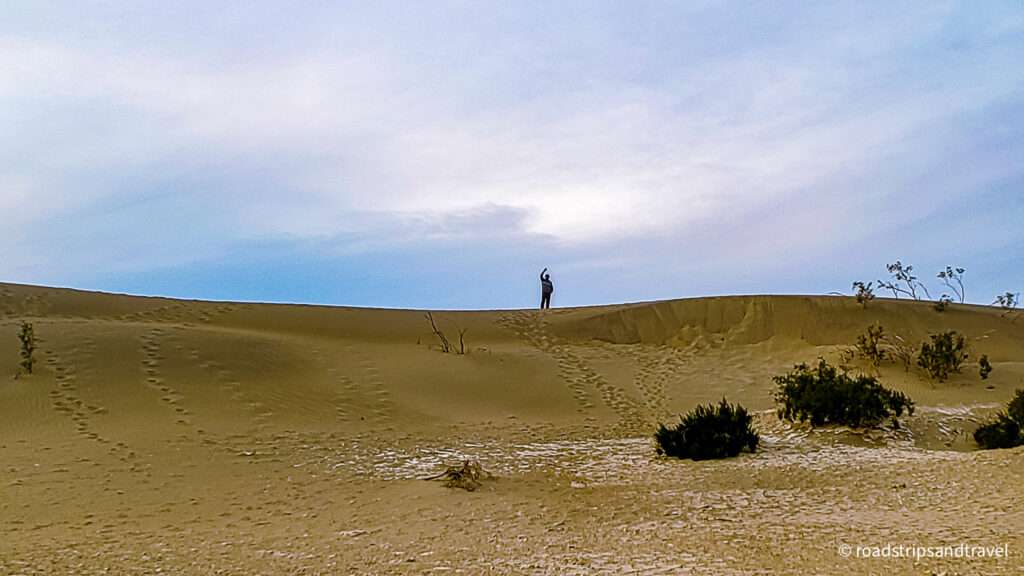
Why are they called Mesquite Sand Dunes?
There is little soil in a sand dune, so plants usually cannot take root. But the sand dunes of Death Valley are unique. Sprawling 14 square miles across the widest part of death valley, these dunes are named after the Mesquite tree which grows in abundance in the area. The Mesquite trees have long taproots which conserve water and flourish along the fringe of these dunes. These trees must twist and grow to avoid being buried by the sand and their leafless brown trunks are often exposed by the shifting sands. But still these trees somehow survive. In spring there are bright green leaves and yellow flowers from the trees’ upper branches. Mesquite bean pods are a traditional food of the Timbisha Shoshone, and the flour from these pods can be purchased in specialty food stores today.
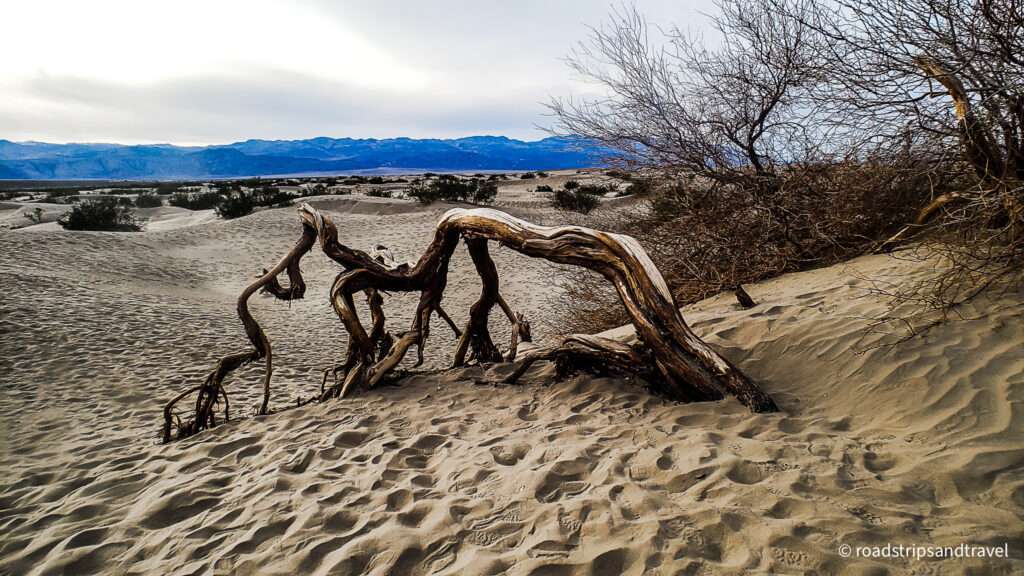
Sand Dunes:
By definition, Deserts are ecosystems that receive fewer than 25 centimeters (10 inches) of rainfall a year. Death Valley National Park receives almost a fifth of that ie around 2 inches of rainfall per year. Deserts are found on every continent and cover about one-fifth of Earth’s land area. Although the word “desert” may bring to mind a sea of shifting sand called dunes, these dunes only cover about 10 percent of the world’s deserts.
Sand is everywhere in the desert, but Sand dunes are not. To understand why, read on for a short Geography lesson.
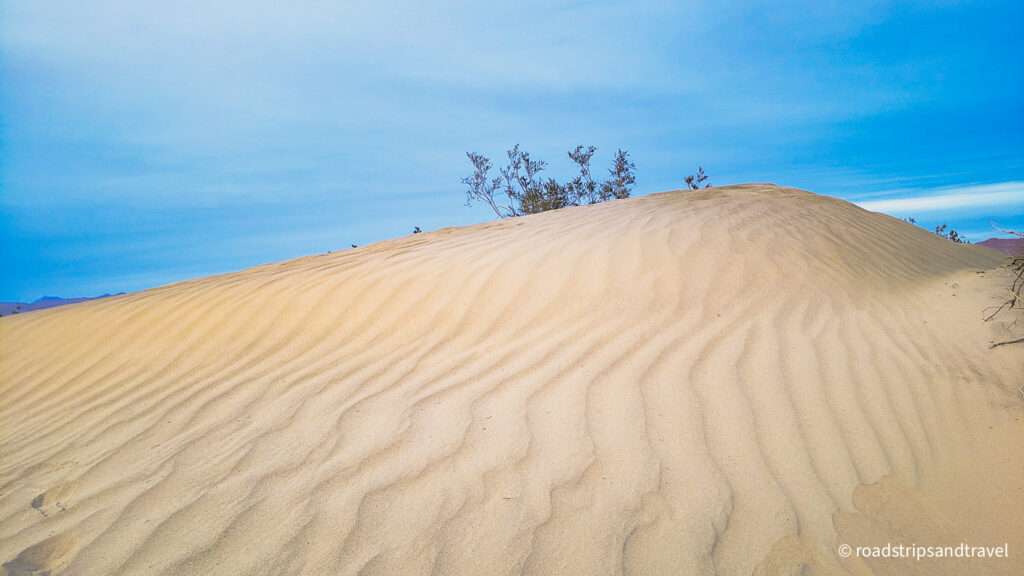
How are Dunes formed?
For sand to gather into dunes, it takes three things:
- A Source of Sand
- A Strong Wind
- Something to Slow the Wind down.
Sand is dormant, but the forces of wind and water move the sand and this causes distinct geological patterns. In Death Valley National Park, the mighty wind erodes the Sand from the mountains surrounding Death Valley. Winds from the north carry sand down the valley until they hit the bulk of Tucki Mountain towering behind the Mesquite Dunes and this causes the sand to collect at its foot. Southerly winds add even more sand and the process repeats. The sand shifts with every windstorm, but the dunes are trapped in place in front of the Tucki Mountain. This is how the dunes in Death Valley are formed.
Types of Dunes:
Every dune has a windward side and a slip face. A dune’s windward side is the side where the wind is blowing and pushing the material up. A dunes slip face is simply the side without wind. A slipface is usually smoother than a dune’s windward side. The wind pattern or rather the absence of it, determines the slip face. Based on the varying wind patterns, you get dunes in different shapes such as Crescentic, Linear, Star, Dome and Parabolic Dunes.
Crescentic Dunes:
This is by far the most common dune form on Earth and they are generally wider than long. The slipface is on the dune’s concave side. These dunes form under winds that blow from one direction, and they also are known as barchans, or transverse dunes.
Linear Dunes:
These dunes have straight or slightly sinuous sand ridges which are typically much longer than they are wide. They generally form sets of parallel ridges and these dunes are formed in bidirectional wind regimes.
Star Dunes:
These dunes are pyramidal sand mounds with slipfaces on three or more arms that radiate from the high center of the mound. They tend to accumulate in areas with multidirectional wind regimes. Star dunes grow upward rather than laterally and are also Radially symmetrical.
Dome Dunes:
These dunes are rare and usually lack a slip face. These Oval or circular mounds occur at the far upwind margins of sand seas.
Parabolic Dunes:
These dunes are formed usually in coastal deserts and contain U-shaped mounds of sand with convex noses trailed by elongated arms. Sometimes these dunes are called U-shaped, blowout, or hairpin dunes and unlike crescentic dunes, their crests point upwind.
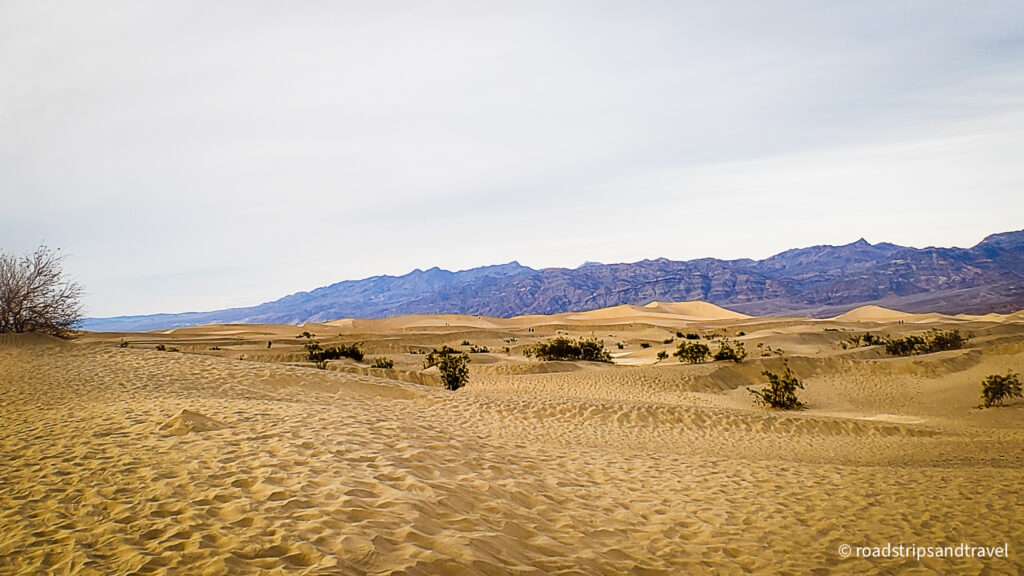
Wildlife and Vegetation:
Apart from Mesquite trees, you can also find creosote bushes which thrive here. These have net-like roots that stabilize the loose sand and allow burrowing animals like Kangaroo rats and Kit fox to burrow without collapsing their dens. You might be fascinated to know that Kangaroo rats can survive without ever drinking any water, getting moisture from their seed diet. Another species which calls the dunes home is the “Sidewinder” rattlesnake. We guess that it takes its name from the way it moves! Rather than struggling through the loose sand like we do, the sidewinder rattlesnake moves gracefully by arching and pushing its body, leaving peculiar J-shaped tracks.
To escape the surface temperature which regularly hits 250 F (120 degree C), the animals escape to underground dens. Temperature underground is cooler and the humidity helps conserve the body moisture. During nights, when the temperature drastically drops, these animals venture out. We were so amazed to learn about these Trees, plants and animals which have adapted to this harsh climate.
As we wonder about this, we can’t help but think that God has a plan for life, even in the midst of a dismal, dreary and desolate landscape! Don’t you agree?

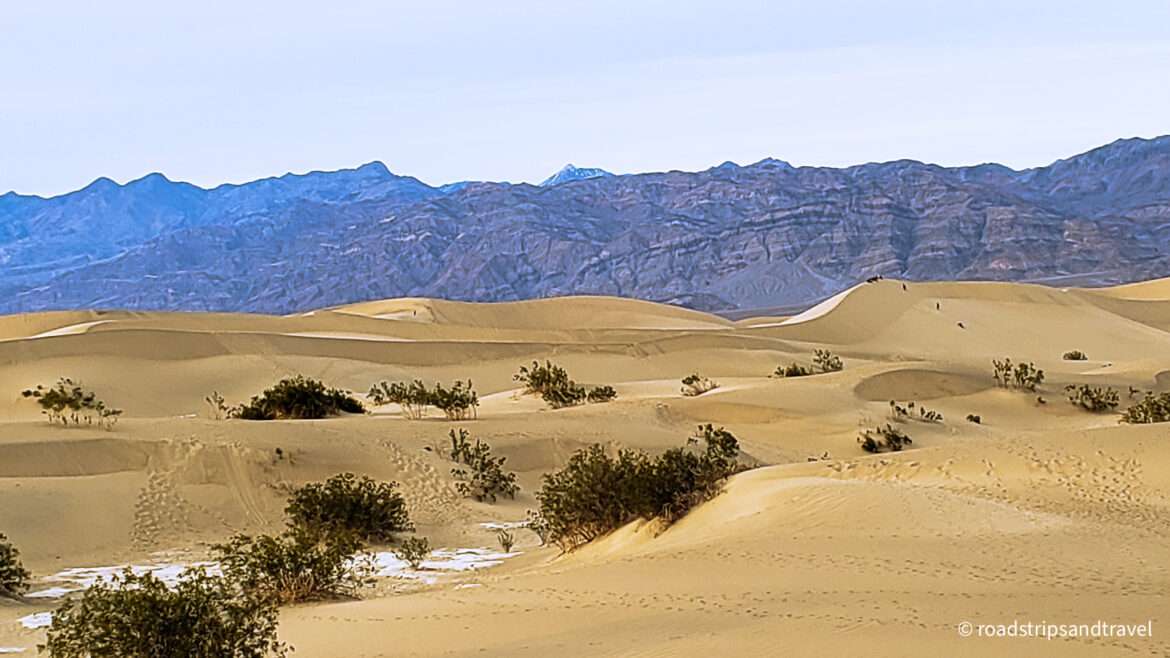
Leave a Reply